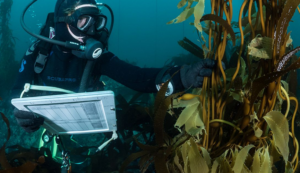California’s MPA monitoring and evaluation program: Promoting healthy oceans in a changing climate

Photo credit: California Sea Grant
California’s collection of 124 marine protected areas (MPAs), which spans the state’s 1,100-mile coastline, is unique in its size, scale, biogeographic and cultural setting, and status as an ecologically connected network. As the MPA network approaches its ten-year anniversary and accompanying first decadal management review in December 2022, Californians want to know: are our MPAs working? In other words, to what extent is the MPA network making progress toward the goals listed in its founding legislation— protecting the state’s natural marine biodiversity, rebuilding depleted populations, and improving ocean health, especially in the face of a changing climate?
Last week, two expert working groups convened by the Ocean Protection Council, the California Department of Fish and Wildlife, and Ocean Science Trust released parallel scientific reports that will help guide the State in answering those questions:
- Climate Resilience and California’s Marine Protected Area Network provides an overview of the threats that climate change poses to California’s coastal and ocean ecosystems, catalogs potential mechanisms through which MPAs could provide resilience in the face of those threats, suggests research questions to deepen our understanding of the link between MPAs and climate resilience, and sets forth recommended actions to support proactive, climate-ready management of California’s MPAs.
- Science Guidance for Evaluating California’s Marine Protected Area Network provides a robust, science-based framework for evaluating MPA performance in California. In particular, the report lists performance evaluation questions, suggests analytical approaches to answer those questions, and identifies important knowledge gaps.
Both of these reports note the importance of continued monitoring to assess ocean health, measure progress toward MPA goals, and support adaptive MPA management in the face of climate change. California has established a statewide MPA monitoring program that is already helping resource managers understand MPA effects. From 2008-2016, teams of scientists conducted baseline monitoring of California’s MPA network to obtain a “snapshot” of ecological and socioeconomic conditions along our coast at the time that MPAs were implemented. Since 2019, guided by the State’s MPA Monitoring Action Plan, scientists have been conducting long-term monitoring in important habitats inside and outside MPAs — rocky intertidal zones, sandy beaches, estuaries and wetlands, kelp forests, and deep rocky reefs — to track changes relative to baseline conditions in important population-level metrics such as fish density, size, and biomass, as well as community-level metrics such as species diversity. Additional research teams are exploring the human dimensions of MPAs, including MPA impacts on recreational and commercial fisheries, and helping to disentangle MPA effects from natural ocean phenomena such as marine heat waves. Importantly, California is partnering on MPA monitoring with coastal Native American Tribes through the recently launched Tribal Marine Stewards Network, which is providing data on the health of culturally important species and places and is also empowering Tribes to monitor and manage their ancestral lands and waters.
So far, monitoring results have been encouraging. Some older, highly protected MPAs such as Point Lobos State Marine Reserve and the Northern Channel Islands MPAs have already demonstrated positive responses to protection, including bigger and more abundant sea life. Scientists have also demonstrated that some MPAs may help to support thriving fisheries via a “spillover” effect in which larval and adult organisms are exported from MPAs to adjacent fished areas, as seen in the Santa Barbara lobster fishery.
Are California’s MPAs making progress towards their goals? And how can the state improve and enhance adaptive management in the face of a changing climate? The wealth of monitoring data and other information that California has gathered over the last ten years will help to ensure that these questions are meaningfully addressed at the upcoming decadal management review.
In the coming weeks, OPC and the California Department of Fish and Wildlife will launch outreach efforts aimed at bringing Californians into the decadal management review — we want to hear what aspects of MPA performance are important to YOU! In the meantime, you can learn more about individual MPA monitoring projects on California Sea Grant’s blog page, and if you want to get involved in monitoring, talk to your local MPA collaborative or check out one of the many community science opportunities listed below:

